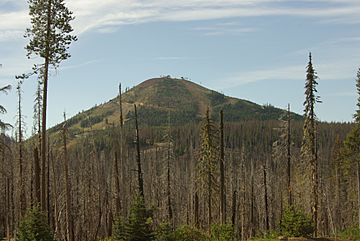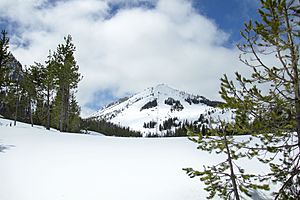Hoodoo Butte facts for kids
Quick facts for kids Hoodoo Butte |
|
|---|---|
 |
|
| Highest point | |
| Elevation | 5,597 ft (1,706 m) |
| Geography | |
| Location | Linn County, Oregon, U.S. |
| Parent range | Cascades |
| Topo map | USGS Santiam Junction |
| Geology | |
| Mountain type | Cinder cone |
| Climbing | |
| Easiest route | Chairlift |
Hoodoo Butte is a cool mountain in northern Oregon. It's a type of volcano called a cinder cone. You can find it in the Cascade Range, close to a place called Santiam Pass.
Right next to Hoodoo Butte is Hayrick Butte. Hayrick Butte is a special flat-topped mountain called a tuya. People think the names of Hoodoo Butte and Hayrick Butte might have been mixed up a long time ago. But the names stuck!
This area has had some big forest fires in the past. Hoodoo Butte is sometimes seen as a smaller part of the Mount Washington shield volcano. It's also part of a long chain of volcanoes called the Sisters Reach. This chain stretches for about 56 miles (90 km).
The Sisters Reach has many volcanoes that are rich in magnesium and iron. Hoodoo Butte is one of them. It has a crater at its top that was protected from glaciers.
A fun ski area called Hoodoo is located on the side of the mountain. It has five chairlifts to take you up! In winter, people also love snowshoeing and snowmobiling here. In summer, you can enjoy fishing, hiking, camping, mountain biking, windsurfing, and water skiing.
Contents
Where is Hoodoo Butte?
Hoodoo Butte is located in Linn County, in the northern part of Oregon. It stands tall at 5,597 feet (1,706 meters) high. The mountain has a big, rounded shape. It rises about 500 feet (150 meters) above the land around it.
This volcano is about 44 miles (71 km) northwest of the city of Bend. It's also about 130 miles (210 km) southeast of Portland.
Nature Around Hoodoo Butte
In 1967, a large forest fire burned about 5,000 acres (20 km²) near Santiam Pass. This fire reached the trees on the eastern and southern sides of Hoodoo Butte. It left some patches of trees, but the northern side still has a thicker forest. More forest fires happened in the summer of 2003.
The soil on the mountain is not very deep. It's often loose and made of cinders, which are small volcanic rocks.
Animals of Hoodoo Butte
You might see different birds near Hoodoo Butte, like woodpeckers and bald eagles. Larger animals like deer and American black bears also live in the surrounding area.
How Hoodoo Butte Was Formed
Hoodoo Butte is in the eastern part of the Cascade Range, called the High Cascades. These mountains were formed a long time ago, towards the end of the Ice Age. They sit on top of older volcanoes.
In the area from Mount Jefferson south to Santiam Pass, you'll find many shield volcanoes. These are broad, gently sloping volcanoes. They often have cinder cones like Hoodoo Butte on their sides. The eruptions here have created different types of volcanic rocks.
Hoodoo Butte is part of the Sisters Reach. This area has many volcanoes that are rich in iron and magnesium. Hoodoo Butte is one of the bigger ones. Other large volcanoes nearby include Three Fingered Jack and North Sister.
Hoodoo Butte is a cinder cone volcano. It has a crater at its top that is still in good shape. This is because a nearby lava dome called Hayrick Butte protected Hoodoo's summit from glaciers during the Ice Age. The crater opens up to the east. This happened because the volcanic rocks that formed the mountain were not spread out evenly.
The cinder cone is surrounded by volcanic ash from other volcanoes. This ash was moved by water. Some of it even settled on the floor of Hoodoo's summit crater.
The Story Behind the Name
There's a local story about how Hoodoo Butte got its name. People say that a mapmaker accidentally switched the names of Hoodoo Butte and Hayrick Butte. The word "hoodoo" usually means tall, thin rock formations. These are seen at Hayrick Butte. "Hayrick" means a stack of hay, which fits the shape of Hoodoo Butte better.
It's not clear if this mix-up really happened. But the names have stayed the same until today. The name Hoodoo Butte was officially confirmed on November 28, 1980.
The very top of Hoodoo Butte has special electronic communication sites. These sites help with phone and internet signals for companies like AT&T.
Fun Activities at Hoodoo Butte
The Hoodoo ski area is a very popular place for winter sports. It covers about 800 acres (3.2 km²) and has 34 different ski trails. There are five chairlifts to take skiers up the mountain. You can also find a snow tubing park, night skiing, and places to eat and rent gear.
The first ski area here was built in 1938. After World War II, it got even better with new buildings and chairlifts. Hoodoo is the oldest ski area in the Central Cascades. It has slopes for skiers of all skill levels. From November 1 to May 15, off-road vehicles are not allowed here.
Besides skiing, snowshoeing and snowmobiling are also popular in winter. In the summer, people enjoy fishing, hiking, camping, and mountain biking. The Hoodoo Ski Bowl offers amazing views of the area.
Fishing is a favorite activity, especially for brook and cutthroat trout at Big Lake. This lake is about 3 miles (4.8 km) south of the ski area. In summer, you can also go boating, windsurfing, and water skiing on the nearby lakes.


